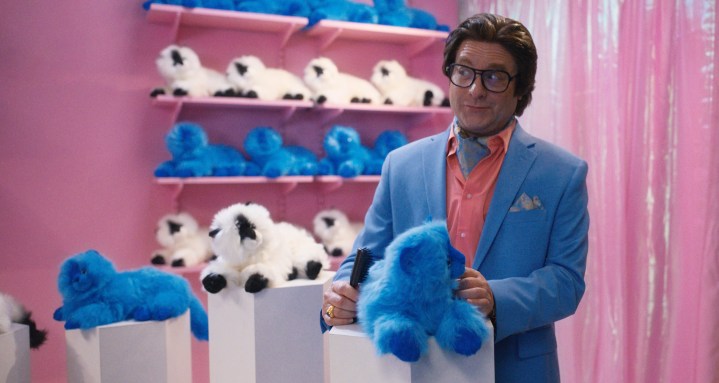
When products are the stars of Hollywood films

This month Econ Extra Credit is taking a look at speculative investment bubbles with some help from Beanie Babies. We’re watching the film “Beanie Mania” from 2021. Subscribe here to get the whole series in your inbox.
It’s ubiquitous now, but the first product placement in movies dates back to 1927’s “Wings,” which featured several close-up shots of Hershey’s chocolate bars.
Nowadays, companies collectively spend billions every year to get their brands subtly and not so subtly placed into film and TV. Deals range from tens of thousands of dollars (perhaps for a product to be placed in the background of a scene) to tens of millions of dollars ( remember when James Bond drank a Heineken? ). “Smurfs 2” back in 2013 got Sony Pictures some $150 million in product placement, $40 million more than the film’s reported production budget.
Product placements can increase awareness and introduce brands to new audiences. But more importantly, they are ads that viewers can’t skip or mute.
“If you were to do a poll about the commercials that ran during the Super Bowl — arguably that is the most watched moment when people actively watch commercials. It’d be interesting to see how many people can recollect the actual products and brands showcased,” said Will Park, vice president of content integration at BENlabs in Los Angeles.
“But if you were to ask what company was in ‘Castaway,’ which came out over 20 years ago, they would probably recall [FedEx] immediately,” he said. “That’s the power of integration.”
American audiences are so used to product placement at this point that they expect it, even embrace it, so long as it’s executed well, according to Siva Balasubramanian, a professor of marketing at the Illinois Institute of Technology who has studied the impact of product placements for more than 30 years.
“There is an overwhelming belief in the consumer movie audiences that product placements actually add value to the movie,” said Balasubramanian. “They make the characters more believable and the story more contextually appropriate.”
Investors may also be more upbeat about a brand they see onscreen. In one study, researchers found that after the release of a successful film, publicly traded companies that had products featured in that film enjoyed a nearly 1% bump in their stock prices.
“One percent is not to be scoffed at,” said Balasubramanian, though he emphasized that product placement studies needed to be replicated before generalizing their results to the larger industry.
Even when a brand doesn’t pay for product placement, it can still see an uptick in demand. That’s the case with “The Beanie Bubble,” despite the feature film’s sour depiction of Ty Warner, the man who created the toys. After its release on Apple TV+, collectors said they saw renewed interest in Beanies, and higher resale values for some rare models. (Please reread last week’s newsletter before you start trading Beanies for profit.)
What is unique about the past five to 10 years is the number of films in which products have been cast in starring roles, so much so that their names are even referenced in the movie title. It’s a trend that Alex Wilson, global executive creative director at Amplify in London, has described as “product as protagonist.”
“A large part of the money-spending consumers out there are now millennials,” said Wilson. “A lot of the creators out there are also millennials. They’re creating stuff that appeals to them; their inspirations are stuff that inspired them as kids.”
Nostalgia also helps increase the appeal of these movies, many of which focus on toys that were popular in the ‘80s and ‘90s.
“Now more than ever, we’re desperate for something that feels comfortable, something feels consistent,” said Wilson. “The future is so unknown, the past is very warm and fuzzy for all of us. No matter how old you are, you’re always gonna have a time that resonates with you.”
But Wilson, Park and Balasubramanian emphasize that consumers nowadays are savvy enough to know when product placements are authentic and when they’re just gimmicks.
“If the story is not good, if it’s not about a character that people care about, it will fall flat,” Park said.
Actor and comedian Randall Park said something similar in a recent interview about “Barbie,” the latest “product as protagonist” success story. He cautioned Hollywood against trying to recreate the blockbuster magic of “Barbie” by simply making more movies about toys. Instead, he said the studios should double down on telling more stories for women, by women.
Still, perhaps Hollywood can have its cake and eat it too. Mattel has a Polly Pocket movie in the works, written and directed by Lena Dunham and starring Lily Collins.
“Beanie Mania” is available to stream on Max with a subscription. Later in the month, we’ll be talking about the new movie dramatizing this phenomenon, “The Beanie Bubble,” which is available to stream on Apple TV+ with a subscription.
After you watch, send us your thoughts and questions at extracredit@marketplace.org or reply to this email!
There’s a lot happening in the world. Through it all, Marketplace is here for you.
You rely on Marketplace to break down the world’s events and tell you how it affects you in a fact-based, approachable way. We rely on your financial support to keep making that possible.
Your donation today powers the independent journalism that you rely on. For just $5/month, you can help sustain Marketplace so we can keep reporting on the things that matter to you.












